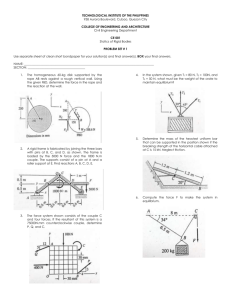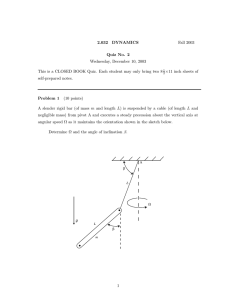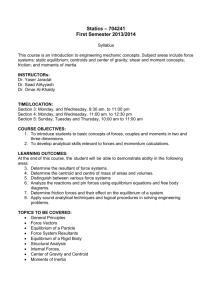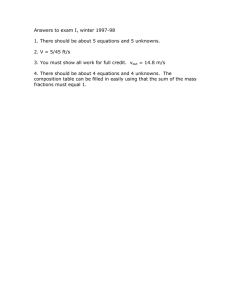CH. VI ME2560 STATICS Equilibrium of a
advertisement
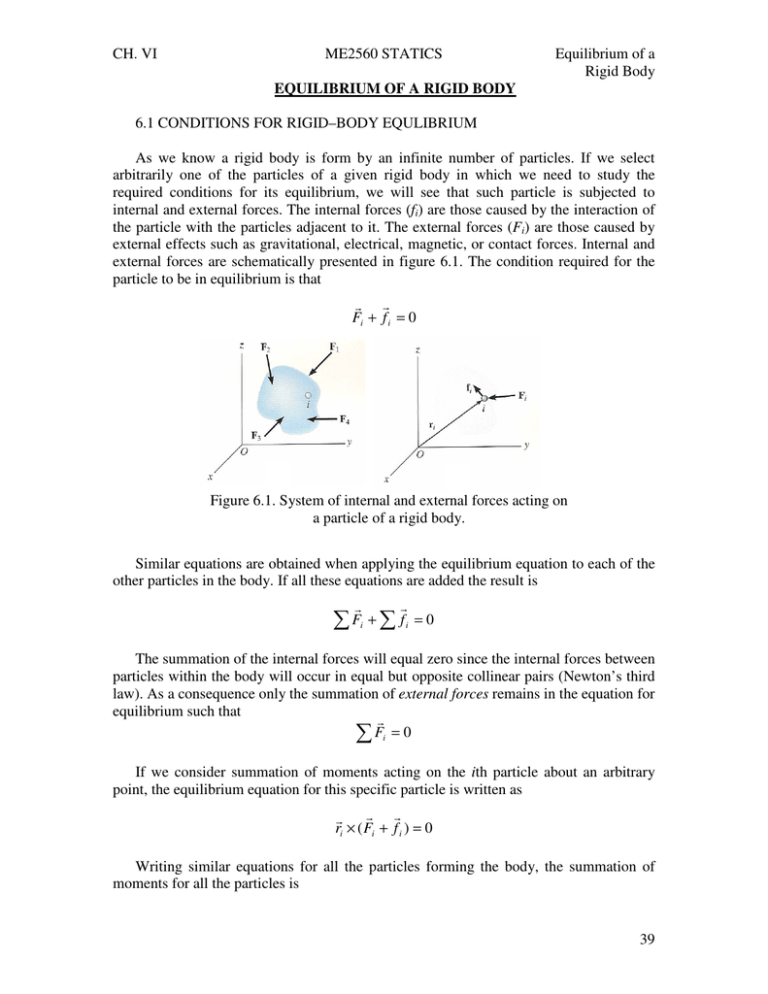
CH. VI ME2560 STATICS Equilibrium of a Rigid Body EQUILIBRIUM OF A RIGID BODY 6.1 CONDITIONS FOR RIGID–BODY EQULIBRIUM As we know a rigid body is form by an infinite number of particles. If we select arbitrarily one of the particles of a given rigid body in which we need to study the required conditions for its equilibrium, we will see that such particle is subjected to internal and external forces. The internal forces (fi) are those caused by the interaction of the particle with the particles adjacent to it. The external forces (Fi) are those caused by external effects such as gravitational, electrical, magnetic, or contact forces. Internal and external forces are schematically presented in figure 6.1. The condition required for the particle to be in equilibrium is that r r Fi + f i = 0 Figure 6.1. System of internal and external forces acting on a particle of a rigid body. Similar equations are obtained when applying the equilibrium equation to each of the other particles in the body. If all these equations are added the result is r r F f + ∑ i ∑ i =0 The summation of the internal forces will equal zero since the internal forces between particles within the body will occur in equal but opposite collinear pairs (Newton’s third law). As a consequence only the summation of external forces remains in the equation for equilibrium such that r ∑ Fi = 0 If we consider summation of moments acting on the ith particle about an arbitrary point, the equilibrium equation for this specific particle is written as r r r ri × ( Fi + f i ) = 0 Writing similar equations for all the particles forming the body, the summation of moments for all the particles is 39 CH. VI ME2560 STATICS r r r r r × F + r ∑ i i ∑ i × fi = 0 Equilibrium of a Rigid Body The second term is zero since the internal forces occur in equal but opposite collinear pairs, therefore the resultant moment of each pair of forces about point O is zero. Thus, r M ∑ o =0 Then, the equilibrium equations for a rigid body are r ∑ Fr = 0 ∑M = 0 (6.1) o 6.2 FREE BODY DIAGRAMS The correct determination of the forces and moments acting on a rigid body highly depends on the correct presentation of the free–body diagram, and since there are a number of different structural supports it is very important to know what class of forces those supports impose on a rigid body. In general, if a support prevents the translation of a body in a given direction, then a force is developed on the body in that direction. If a support prevents rotation, then a couple moment is exerted on the body. Figure 6.2 presents three of the most common supports. Figure 6.2(a) shows a beam supported on one of its ends by a roller. Since the support only prevents the movement in the vertical direction, the roller can only exert force on the beam in the vertical direction. In figure 6.2 (b) the beam is supported in a more restrictive manner using a pin. In this case the pin prevents the translational movement in any direction; therefore the resultant reaction on the beam will consist on a force with components in both directions. Finally, figure 6.2 (c) presents a fixed support. This is the most restrictive support since prevents any kind of translational and rotational motion. Thus, the reaction on the beam will consist on a force with components in the vertical and horizontal directions and a couple moment that prevents rotation. (a) (b) (c) Figure 6.2. Three of the most common supports. 40 CH. VI ME2560 STATICS Equilibrium of a Rigid Body Table 6.1. Two dimensional supports and their reactions. Types of Connection Reaction Number of Unknowns (1) One unknown. The reaction is a tension force which acts away from the member in the direction of the cable. (2) One unknown. The reaction is a force which acts along the axis of the link. (3) One unknown. The reaction is a force which acts perpendicular to the surface at the point of contact. (4) One unknown. The reaction is a force which acts perpendicular to the slot. (5) One unknown. The reaction is a force which acts perpendicular to the surface at the point of contact. (6) One unknown. The reaction is a force which acts perpendicular to the surface at the point of contact. 41 CH. VI ME2560 STATICS Equilibrium of a Rigid Body Table 6.1. Cont. (7) One unknown. The reaction is a force which acts perpendicular to the rod. (8) Two unknowns. The reactions are two components of force, or the magnitude and direction Φ of the resultant force. Note that Φ and θ are not necessarily equal [usually not, unless the rod shown is a link as in (2)]. (9) Two unknowns. The reactions are the couple moment and the force which acts perpendicular to the rod. (10) Three unknowns. The reactions are the couple moment and the two force components, or the couple moment and the magnitude and direction Φ of the resultant force. 42 CH. VI ME2560 STATICS Equilibrium of a Rigid Body External and Internal Forces Since a rigid body is formed by an infinite number of particles, both external and internal loadings may act on it. However, when preparing a free–body diagram the internal forces are not presented in the diagram since these forces always occur in opposite collinear pairs having a net effect of zero on the body. Weight and Center of Gravity When a body is subjected to a gravitational field, each of its particles has a specified weight. The sum of all the individual weights represents the weight of the body W and the location where this weight W acts corresponds to the center of gravity. Homework No. 6.1: 5–9, 5–10. 6.3 EQUATIONS OF EQUILIBRIUM The conditions sufficient and necessary to ensure equilibrium in a rigid body are: summation of forces equal to zero and summation of moments equal to zero. In a coplanar system, these equations are reduced to: ∑F x =0 ∑F y =0 ∑M o =0 (7.2) 6.4 TWO– AND THREE–FORCE MEMBERS Two–Force Members. When a member is subjected to no couple moments and forces are applied only at two points on the member, the element is called two–force member. Figure 6.3 shows some typical examples of two–force members. FB=–FA Figure 6.3. Two force members frequently found. 43 CH. VI ME2560 STATICS Equilibrium of a Rigid Body Three–Force Members. If a member is subjected to only three forces then it is necessary that the forces be concurrent or parallel for the member to be in equilibrium. F1 Figure 6.4. Three force member. Homework No. 6.2: 5–21, 5–23, 5–27, 5–36, 5–51, 5–62. 6.5 EQUILIBRIUM IN THREE DIMENSIONS Similarly as in the case of equilibrium in coplanar systems, the first step in three dimensional problems is to draw a free–body diagram. It is also of vital importance to set the proper reactions at the supports. The reactive forces and couple moments acting at various types of supports and connections are shown in table 6.2. As in the two dimensional case, a force is developed by a support that restricts the translation of the attached member, whereas a couple moment is developed when the rotation of the attached member is prevented. 44 CH. VI ME2560 STATICS Table 6.2. Three dimensional supports and their reactions. Types of Connection Reaction Equilibrium of a Rigid Body Number of Unknowns (1) One unknown. The reaction is a force which acts away from the member in the known direction of the cable. (2) One unknown. The reaction is a force which acts perpendicular to the surface at the point of contact. (3) One unknown. The reaction is a force which acts perpendicular to the surface at the point of contact. (4) Three unknowns. The reactions are three rectangular force components. (5) Four unknowns. The reactions are two force and two couple-moment components which act perpendicular to the shaft. 45 CH. VI ME2560 STATICS Equilibrium of a Rigid Body (6) Five unknowns. The reactions are two force and three couple-moment components. (7) Five unknowns. The reactions are three force and two couple-moment components. (8) Five unknowns. The reactions are three force and two couple-moment components. (9) Five unknowns. The reactions are three force and two couple-moment components. (10) Six unknowns. The reactions are three force and three couple-moment components 46 CH. VI ME2560 STATICS Equilibrium of a Rigid Body EQUATIONS OF EQUILIBRIUM The conditions for equilibrium if a rigid body subjected to a three dimensional force system require that both the resultant force and the resultant couple moment acting on the body be equal to zero. The two equations for equilibrium in a rigid body can be expressed in vector form as r F ∑ =0 r M ∑ o =0 (6.3) In these equations ΣF is the vector sum of all the external acting on the body and ΣMo is the sum of the couple moments and the moments of all the forces about any point O located either on or off the body. The two equations presented in Eq. (6.3) can be alternatively presented as r ∑ F = ∑ F iˆ + ∑ F ˆj + ∑ F kˆ = 0 r ∑ M = ∑ M iˆ + ∑ M ˆj + ∑ M kˆ = 0 (6.4) ∑F ∑M (6.5) x o y x z y z Or also as =0 x x =0 ∑F ∑M =0 y y =0 ∑F = 0 ∑M = 0 z z Homework No. 6.3: 5–65, 5–69, 5–75, 5–81, 5–83, 5–84. 47
